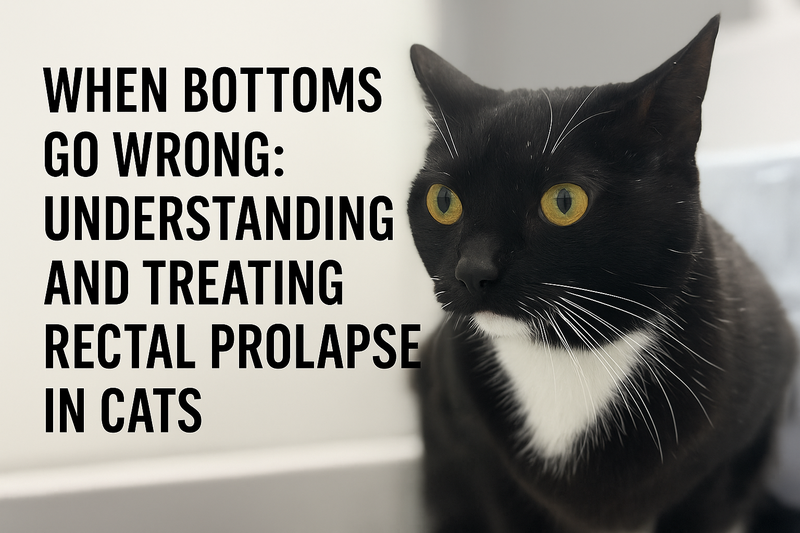After Hours
0408 512 323
Popular Posts
When Bottoms Go Wrong: Understanding Rectal ProlapseCorns in GreyhoundsFeline Idiopathic Cystitis (FIC): Why Winter Brings More Trouble for Your Cat’s BladderDon’t Let Ear Infections Become a Life-Long Problem for Your Dog: What You Can Do—and How We Can HelpWhy Vet Checks, Vaccinations & Health Screens Matter for Your Pet’s Wellbeing
When Bottoms Go Wrong: Understanding and Treating Rectal Prolapse in Cats
At Eureka Veterinary Clinic in Ballarat, we recently cared for a beautiful black and white cat named Nala, who had been in and out of the clinic with a worrying issue—a rectal prolapse. After trying conservative management, the decision was made to perform an abdominal colopexy surgery. We’re pleased to say Nala has recovered well, and her story highlights just how treatable this condition can be with the right care.
Here’s what you need to know about rectal prolapse in cats and how we can help.
What Is Rectal Prolapse?
Rectal prolapse occurs when part of the rectum slides out through the anus, forming a red, swollen, tube-like structure. It can look dramatic—and understandably causes concern for pet owners—but with timely intervention, cats can recover very well.
This condition may start suddenly and can range from mild to severe, but the good news is that treatment is available and often very effective.
Why Does It Happen?
Rectal prolapse is typically caused by excessive straining, either from digestive, urinary, or reproductive issues. Common causes include:
- Chronic constipation or diarrhoea
- Parasites or intestinal infections
- Reproductive or urinary tract conditions causing abdominal tension
- Rarely, tumours or anatomical weaknesses in the pelvic region
In Nala’s case, persistent straining and loose stools meant her rectum repeatedly prolapsed, even after initial treatments. That’s when our surgical team stepped in.
What to Watch For
If your cat is affected, you may see:
- A red, soft, tubular mass protruding from the anus
- Straining to defecate, often without passing anything
- Blood in the stool or discomfort when toileting
- Hiding, reduced appetite, or signs of pain
If you notice these signs, please contact us right away. Early diagnosis and intervention make all the difference.
Diagnosis at Eureka Vet
We begin with a gentle yet thorough approach:
- Physical and rectal examination
- Blood tests and abdominal imaging to assess for underlying disease
- Faecal analysis to rule out parasites or infections
This helps us tailor a treatment plan that gets to the root of the problem—not just the symptoms.
Treatment Options
Mild Cases
For first-time or minor prolapses, we may:
- Gently reposition the rectum under anaesthesia
- Use a temporary suture (purse-string) to keep things in place
- Prescribe anti-inflammatories, parasite treatments, and dietary support (moist, high-fibre foods)
This approach can be effective if the underlying cause is addressed early.
When Surgery Is Needed: Colopexy
In Nala’s case, the prolapse recurred multiple times. We recommended a colopexy, a surgery that anchors the colon to the inside of the abdominal wall to prevent future prolapse.
At the Eureka Veterinary Clinic, we perform open abdominal colopexy in-house, using tried-and-true surgical techniques. This allows us to treat complex cases without referring pets away from their local care team.
Postoperative Care and Prevention
Following colopexy surgery, we focus on:
- Pain relief and antibiotics if needed
- Tailored nutrition—usually soft, easily digestible food
- Ongoing parasite prevention and monitoring for any future digestive issues
To reduce the chance of recurrence, we recommend:
- Regular worming and faecal checks
- Moist diets to support smooth bowel movements
- Early treatment of any straining or abnormal toileting behaviour
Why Choose Eureka Vet?
🩺 Advanced surgical care, close to home: We manage prolapse cases right here in Ballarat—no stressful travel, no referrals.
🤝 Compassionate partnership: We involve you in every step of your pet’s care, treating each case with respect, care, and professional insight.
💡 Full-service follow-up: From diagnosis through recovery, we provide clear communication and tailored aftercare.
Nala’s Story: A Happy Ending
Thanks to a dedicated owner and a team approach, Nala is now back to her confident, playful self—with no more trouble at her rear end. Her case is a perfect example of how proactive care, timely surgery, and good communication lead to excellent outcomes.
If you ever notice straining, discomfort, or something unusual around your cat’s bottom, don’t wait. Contact our team at Eureka Vet—we’re here to help.
📞 Call us today to book an appointment or speak with one of our experienced vets.
CLICK HERE for available times and bookingsBOOK ONLINE >
Location



